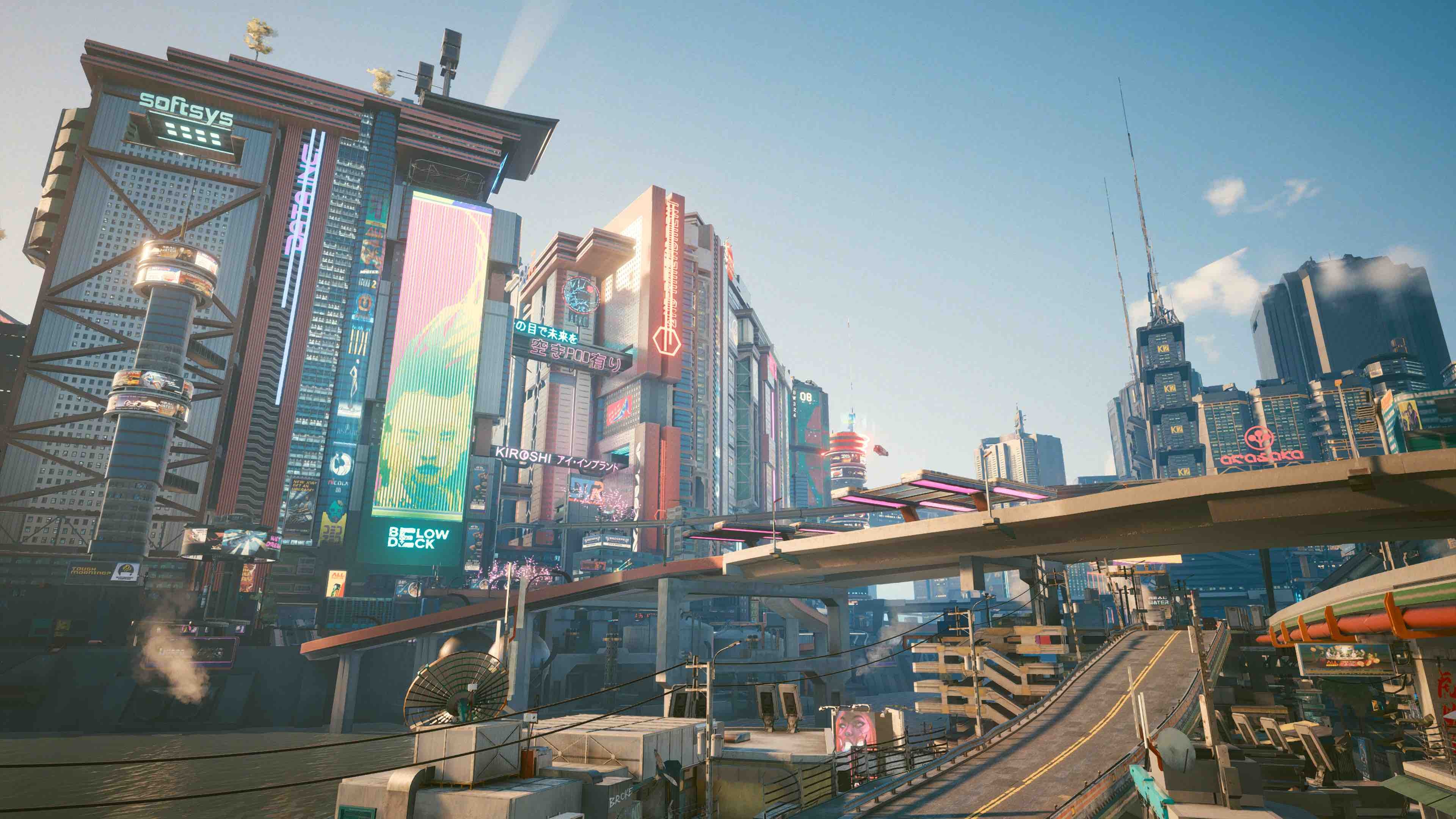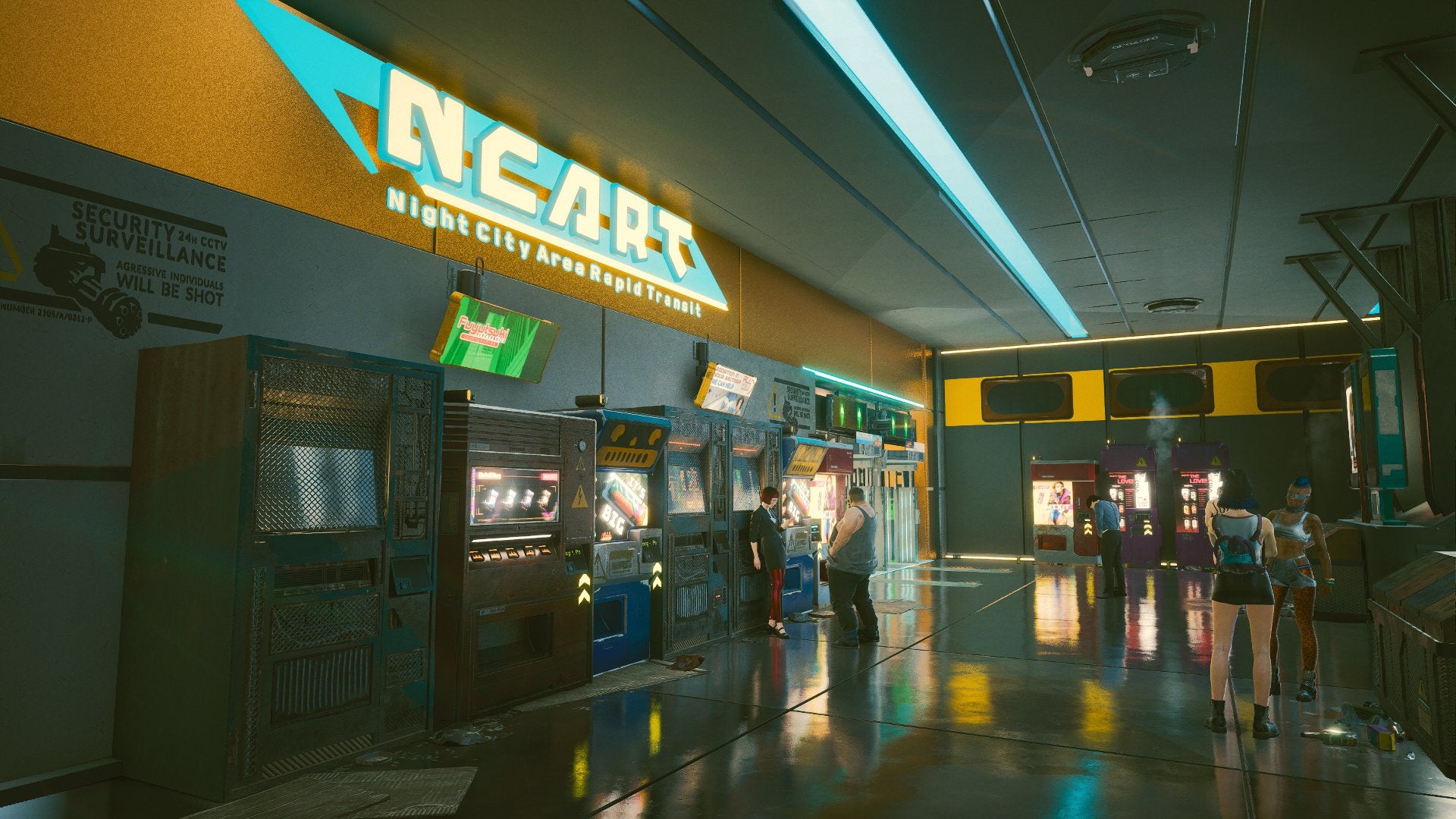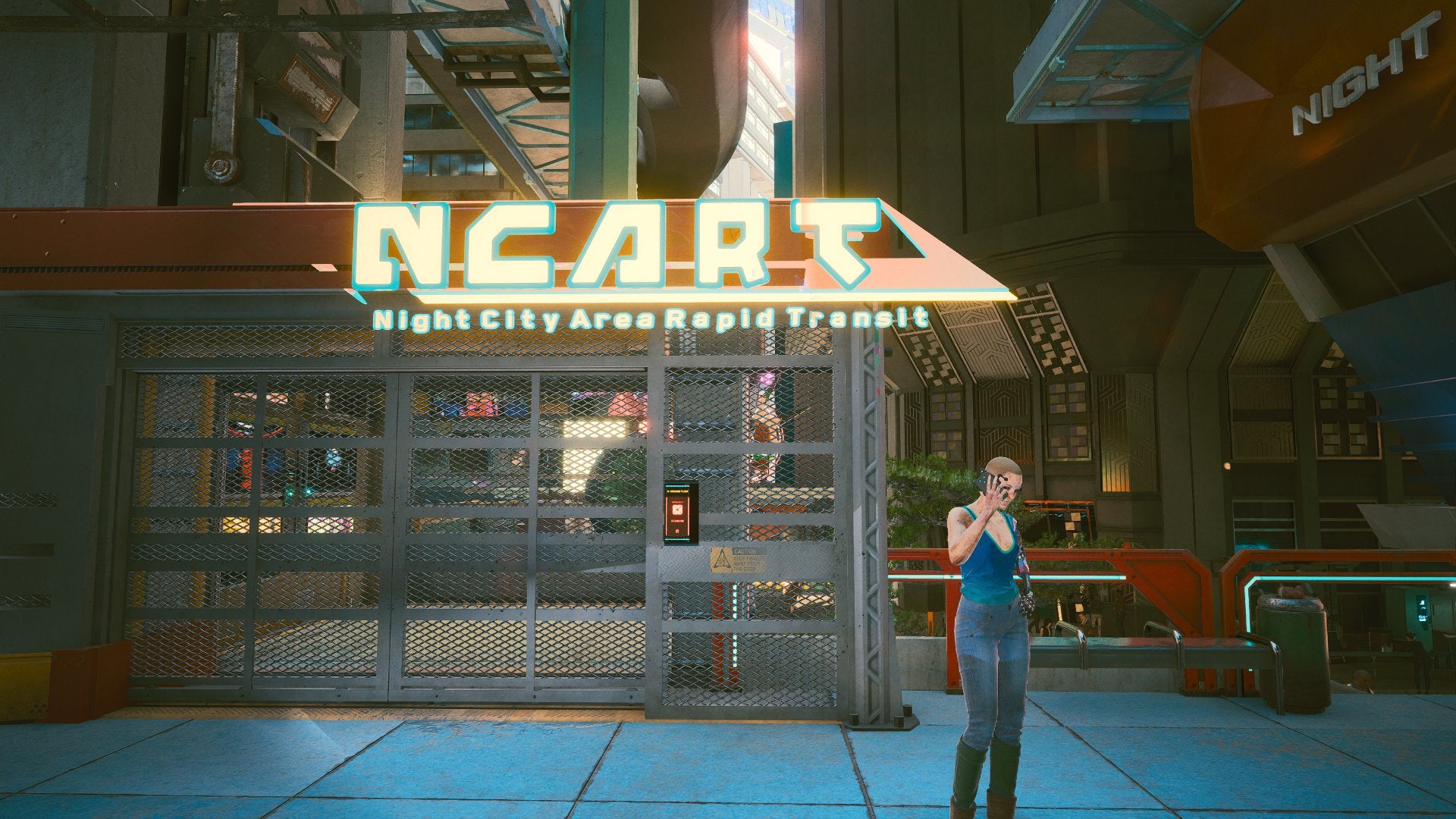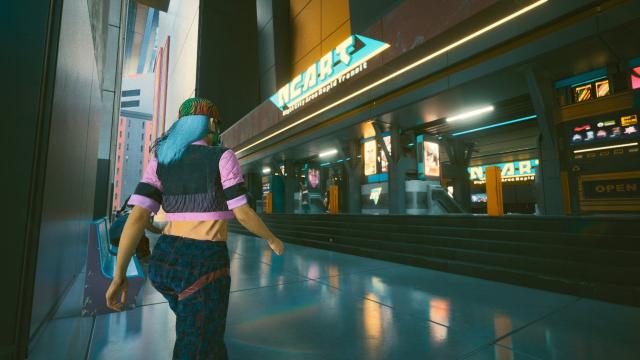When it comes to offering plausible visions of the future, the cyberpunk genre tends to fall just short of perfection. Eidos Montreal’s trench coat runway show, Deus Ex: Mankind Divided, portrayed a convincing version of near-future Prague but royally screwed up how vents work. DICE’s parkour sim Mirror’s Edge: Catalyst forgot that life has more than three colours. And the latest gazillion-dollar cyberpunk playground, CD Projekt Red’s Cyberpunk 2077, really doesn’t understand how people get around.
Technically, according to a transit expert I spoke to, the game is a decent representation of the dysfunction-addled American transit systems of today. And for sure, Cyberpunk 2077 never intended to portray a rosy view of the future. But still, despite its arguably performative throughline of caustic cynicism, the game’s portrayal of futuristic transit leaves a lot to be desired.
For our real future, shouldn’t we dream a bit bigger? I think so. I sure as hell hope so.
In terms of modern game launches, few, of course, are more notorious than Cyberpunk 2077’s. Following three delays, CDPR’s open-world role-playing shooter hit consoles and PC in December 2020. Though it worked just fine on high-end PCs, it floundered on consoles, particularly straining the capabilities of seven-year-old PS4s and Xbox Ones. Over the past year and a half, CDPR released a flurry of updates — major and patchwork — culminating in a massive patch in February that totally overhauled the game, and even gave all of its citizens faces. The studio now considers its work on Cyberpunk 2077 mostly done, with the bulk of development resources moved to other projects (like a new Witcher game).
Through the tumult, if there was one part of Cyberpunk 2077 you couldn’t knock in good faith, it was its sense of place. The setting, Night City — the geographical bedrock of Cyberpunk canon dating back to its days as a tabletop RPG — is an eye-poppingly vivid rendition of what life in coastal California could look like in 2077. Even though the game’s human NPCs often acted anything but human, the city itself was a decidedly human place, an AutoCAD marvel, a sprawling metropolis with en plein air plazas and tight clusters of neon-coated skyscrapers.
In short, strolling through Night City has always felt like strolling into the future.

Forget all that. As Kotaku’s in-house NUMTOT, I had to know: Yeah, sure, Night City is real-feeling, but how does its transit stack up? Are these systems what we can look forward to in American cities 55 years from now? Will the looming cloud of flashy new advancements — whether it’s automation or ill-advised “boring” tech — totally transform how we get from point A to point B?
Jerome Horne, director of transit leadership development at TransitCenter, a nonprofit organisation that traffics in transit advocacy, told me I was thinking about it all wrong. For starters, the problems that afflicted public transit programs a century ago are the same problems that affect transit programs today. A century from now, transit systems will still face the same problems.
“Technology does not change geometry,” Horne said in a video call. “As we like to say, ‘A hundred years ago, an elephant could not fit into a wine glass.’ Today, an elephant could not fit into a wine glass. And a hundred years from now, assuming they stay the same size, yeah, an elephant is not really able to fit in a wine glass.”
To be clear here, I’m not concerned with Cyberpunk 2077’s fast-travel system, which is pretty functional, in terms of its efficacy as an in-game feature. I’m talking specifically about the transit system: the scant few fast-travel spots designated as train stations and bus stops.
A good transit system, Horne told me, should be multimodal — meaning it encompasses not just a network of trains but also folds in trams, buses, light rails, bike shares, streetcars, trolleys, and so on. That network should cover most of the city, with stations situated no further than a quarter-mile apart, to avoid so-called “transit deserts.” Routes should run for most of the day, if not around the clock. Headways, or the time you have to wait between scheduled service, ideally shouldn’t be longer than 10 minutes, tops. And the ride itself should always be free. (As for where a country could, hypothetically, get the funds? “The military!” Horne said, noting that approximately 5 per cent of the American war machine’s terminally bloated budget could fund free fares across the country.)

By some of those metrics, Night City’s transit system, formally called Night City Area Rapid Transit (NCART), is indeed world-class. It’ll never cost you, the player, a penny to ride. Three cheers for the protagonist mentality. (That said, it’s safe to assume the NPCs have to pay, since the subway stations have some intense fare gates.) And because Cyberpunk 2077 is a video game, those services actually operate on instant headways; you never have to, say, wait for a train to pull into the station at the Metro: Eubinke fast-travel spot. New York, take notes please!
Where the system falls short is its multimodality. You see, NCART encompasses just two types of public transit: subways and buses.
Even worse is its coverage. Of the 150 fast-travel spots in Night City, fewer than 20 are transit stations. For a city of 5 million people, that is a pittance. (Berlin, a city of roughly 4 million, has 170 metro stations servicing 10 lines, to say nothing of its many stops for alternate modes. The slightly smaller Paris is serviced by more than 300 stations.) In some centrally located regions of Night City, like the waterfront Watson district, station density is commendable. You never have to venture more than 150 meters to find one — a figure way under than the quarter-mile that transit advocates wanna see. But in the outer reaches, you might find stops situated thousands of meters apart, or more. Not great!
For the most part, if you’re getting around Night City, you’re probably doing so behind the wheel.
It’s this — not the corporate-run government, or the “brain dances,” or the overall cynicism — that frightens me most about Cyberpunk 2077. All that stuff is speculative. America’s collective detest of transit, however, is very real. Right now, there’s not a single city in the United States with good service, and if Night City is indicative of where we’re heading, that’ll remain the case 50 years from now.
It is unclear if revamping Night City’s transit network was ever part of CDPR’s development process, or if it even registered as a blip on the studio’s presumably mile-long list of priorities. Through a representative, CDPR declined to comment for this story.
Fixing Night City’s defunct transit network isn’t impossible. It’d just need, well, the same proposed solutions that’d get networks of current U.S. cities back on the right track. That starts with construction — not just a ton of building, but also savvy prioritisation of building a mix of stuff.
“No one mode should be prioritised,” said Horne. “They all work together … depending on the distance of the trip and the amount of people that need to be moved in that particular space.”
In other words, NCART’s pencil pushers would need to invest not just in more subways but also all those other aforementioned modes. Maybe you have bus rapid transit connecting two disparate subway lines, or a light rail circumventing a high-density business district.
Logistically, in terms of moving people around as efficiently as possible, investing in multimodal transportation makes sense, but there’s also a fiduciary impetus: Subway construction costs are substantially more expensive in America than in Europe. It costs way less to buy a few buses and build a few bus shelters than it does to bore a tunnel, lay down track, invest in third rails, purchase train stock, set up fare gates, and all the other costs associated with subway infrastructure development.

As a north star, NCART would work toward implementing automated service across all modes. In an ideal future, Horne likened it to how, following the advent of the automatic elevator, high-rise architects implemented the tech into designs as second-nature as, say, windows or doors. “Every time a new building was built, it was built with automatic elevators. Or if an elevator was replaced in a building, an automatic elevator was installed,” he said. “You’re actually seeing this [now] because there are a number of new sorts of subway systems that are being built and they’re completely automated.”
Right now, though, despite existing across the globe, fully automated systems are extremely rare in America. New York City recently started implementing tech called communications-based transit control (CBTC). Under CBTC, subway signals rely on wireless connectivity rather than outdated analogue systems. The results are genuinely life-changing, slashing formerly excruciating headways down to minutes. But it’s taken years, not to mention some seriously elongated interruptions to service, for the city to implement it.
To date, just two of the city’s 36 train lines are equipped with CBTC.
It’s the babiest of baby steps toward full automation, for sure. Ideally, though, a fully automated network encompasses every mode — light rails, streetcars, buses too — and is legitimately automatic, as opposed to the mixture of computer-driven and human-piloted elements of CBTC.
“We’re still quite a long ways off from there,” Horne said. “We can’t even get Tesla cars to not, you know, run off the street or kill people. So we are a long, long ways off.”
Like all good policy shifts, good transit isn’t something that happens overnight. You can’t just waltz into the White House and flip on the “America And we needn’t reinvent the wheel here either! Many world-class cities already have it figured out: the multimodality of Mexico City, the circumferential subway of Amsterdam, the automated metros of Copenhagen and Vancouver, the sheer quality of service in cities like Berlin, Paris, Melbourne, Tokyo, Shanghai, Beijing. Even Toronto, which currently has just three subway lines, far outpaces any of its southern neighbours in terms of transit accessibility.
“Well, there really aren’t any good examples in the U.S.,” Horne said. “We’re working on it!”
Here’s hoping the work is done fast — and that any solutions that weren’t implemented yesterday are in the pipes. Otherwise, we might end up with cities resembling the fume-choked car sewers of Night City.

Leave a Reply